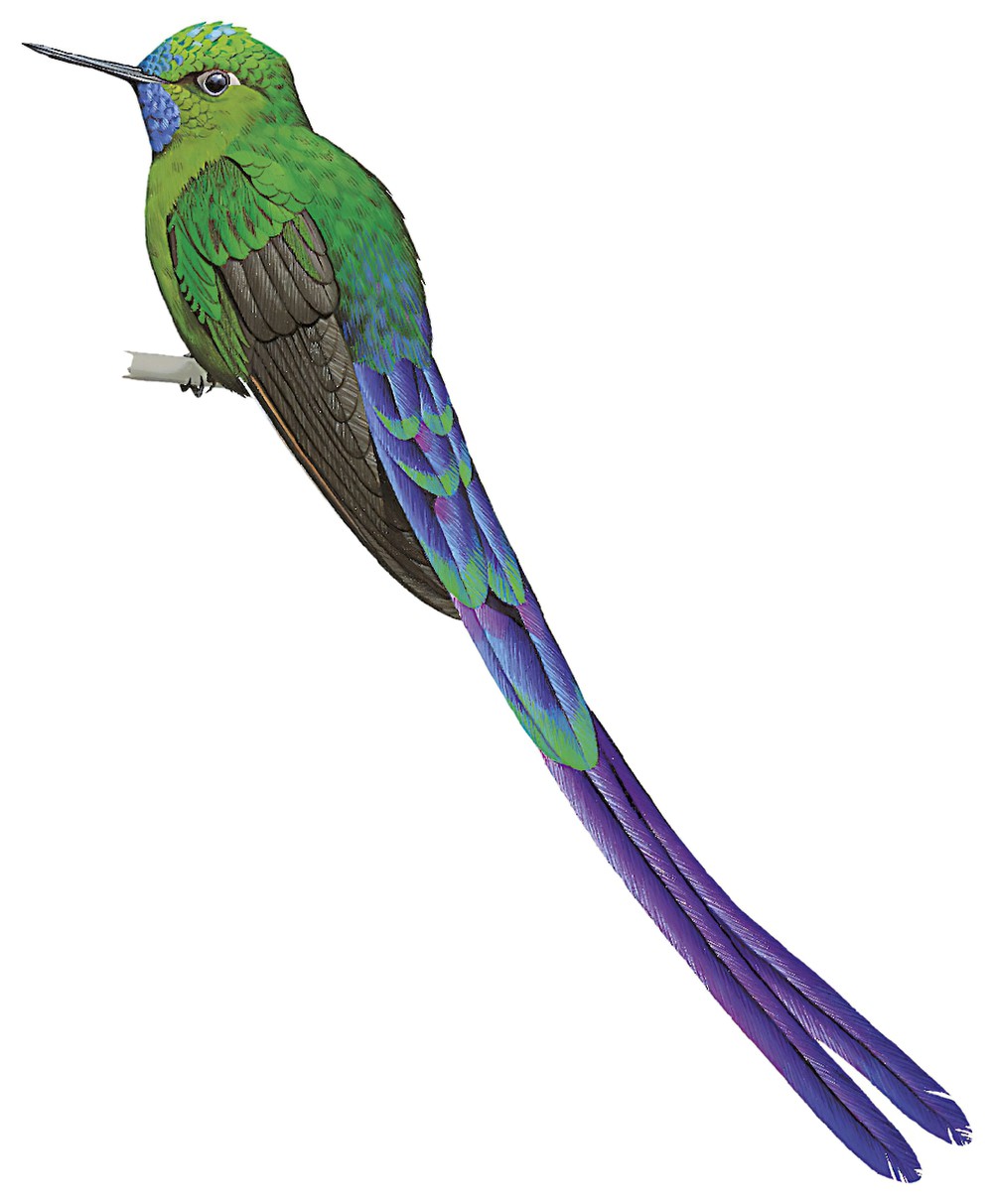Violet-tailed Sylph / Aglaiocercus coelestis

Violet-tailed Sylph
SCI Name:
Protonym: Cynanthus coelestis Intr.Trochil. p.102
Taxonomy: Caprimulgiformes / Trochilidae / Aglaiocercus
Taxonomy Code: vitsyl1
Type Locality: Ecuador.
Author: Gould
Publish Year: 1861
IUCN Status: Least Concern
DEFINITIONS
AGLAIOCERCUS
(Trochilidae; Ϯ Blue-throated Sylph A. kingii) Gr. αγλαια aglaia splendour, beauty < αγλαος aglaos splendid; κερκος kerkos tail; "Lesbia Lesson 1833 (Troch. Index Gen., p. XVII, 1833) contained three species, sapho, nuna, and kingii. Gray three times designated Trochilus forficatus Linnaeus as type species under the mistaken notion that kingii was a synonym, but since forficatus was not among the original species, these designations are invalid. Salvin (Cat. Birds. Brit. Mus., 16, p. 146, 1892) seems to have been the first to comply with modern requirements when he designated nuna as the type of Lesbia. Incidentally this requires the use of Lesbia for the genus known recently as Psalidoprymna, but it leaves the present genus without a name. To supply the deficiency I propose the name Aglaiocercus with Ornismya kingii Lesson as type species." (J. T. Zimmer 1930).
Synon. Cyanolesbia.
coelestis
L. coelestis or caelestis heavenly, glorious < caelum heaven (cf. Med. L. celestis sky-blue).
SUBSPECIES
Violet-tailed Sylph (coelestis)
SCI Name: Aglaiocercus coelestis coelestis
coelestis
L. coelestis or caelestis heavenly, glorious < caelum heaven (cf. Med. L. celestis sky-blue).
Violet-tailed Sylph (aethereus)
SCI Name: Aglaiocercus coelestis aethereus
aethereus
L. aetherius on high, of the air, heavenly < aether, aetheris upper air, heaven < Gr. αιθηρ aithēr, αιθερος aitheros ether, heaven.
● Epithet given to the Large-tailed Potoo because it is supposed to rise high in the air and hover like a falcon; “welch ich C. aethereus nannte, da er bis zu einer bedeutenden Höhe in die Luft steigt, und dort gleich einem Falken schwebend steht” (zu Wied-Neuwied 1820) (Nyctibius).
● “It is called the Tropic-bird because it is found about the Latitude of the Tropic circles, and no where else, so far as hath been by our English Travellers hitherto observed” (Ray 1678); "67. PHAËTHON. ... æthereus. 1. PH. rectricibus duabus longissimis, rostro serrato, digito postico adnato. Avis tropicorum. Catesb. car. 3. p. 14. t. 14. Raj. av. 123. Will. orn. 250. t. 76. Edw. av. 149. t. 149. f. 1. Sloan. jam. I. p. 22. Kalm. iter. 2. p. 149. Osb. iter. 291. Avis Rabos forcados. Aldr. orn. l. 20. p. 544. Habitat in Pelago inter tropicos. Osbeck. Magnitudo Anatis, alba supra lineis nigricantibus undulata tota; subtus immaculata. Fascia nigra per oculos. Rostrum sanguineum, compressum, rectius quam P. Piscatoris, retrorsum serratum. Pedes pallidi, extrorsum nigri, digito quarto etiam membrana affixo. Remiges omnes subtus albæ: primores supra latere exteriore nigræ; secundariæ supra linea longitudinali nigra. Rectrices albæ in cauda cuneiformi, versus apicem lineola subsagittata fusca; omnes supra rachi nivea." (Linnaeus 1758) (Phaethon).
UPPERCASE: current genus
Uppercase first letter: generic synonym
● and ● See: generic homonyms
lowercase: species and subspecies
●: early names, variants, mispellings
‡: extinct
†: type species
Gr.: ancient Greek
L.: Latin
<: derived from
syn: synonym of
/: separates historical and modern geographic names
ex: based on
TL: type locality
OD: original diagnosis (genus) or original description (species)












